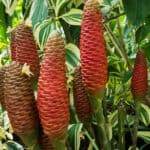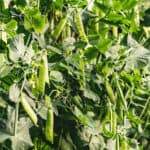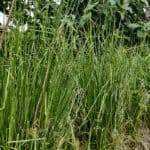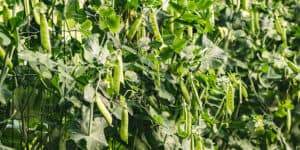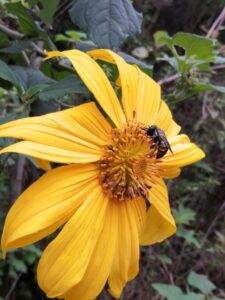Sweet Potatoes are a delicious and cherished food. They’re comforting, nourishing, and make any occasion homely. They’re an ingredient that fits any type of meal, be it sweet or savory, and is enjoyed by even the pickiest of eaters.
Besides being a pleasure to eat, Sweet Potatoes are also delightful and rewarding to cultivate. Given a proper start, they grow quickly and vigorously with lush and attractive foliage. In fact, it’s not uncommon to see them used as ornamental plants. They rarely have serious issues with pests or disease, and if the climate permits you may even see their delicate flowers. The real fun comes during the harvest when you reveal the bounty hidden within the soil!
After all, the harvests can be plentiful. A study by the United Nations Food and Agriculture Organization showed that Sweet Potatoes are the most efficient staple crop on the planet, yielding the highest nutritional content per unit area of land. All these factors make it no surprise that Sweet Potatoes are ranked as the 6th most important staple crop on the planet according to some measures. Their importance to the global food supply is particularly true for subsistence farmers and communities in the global south.
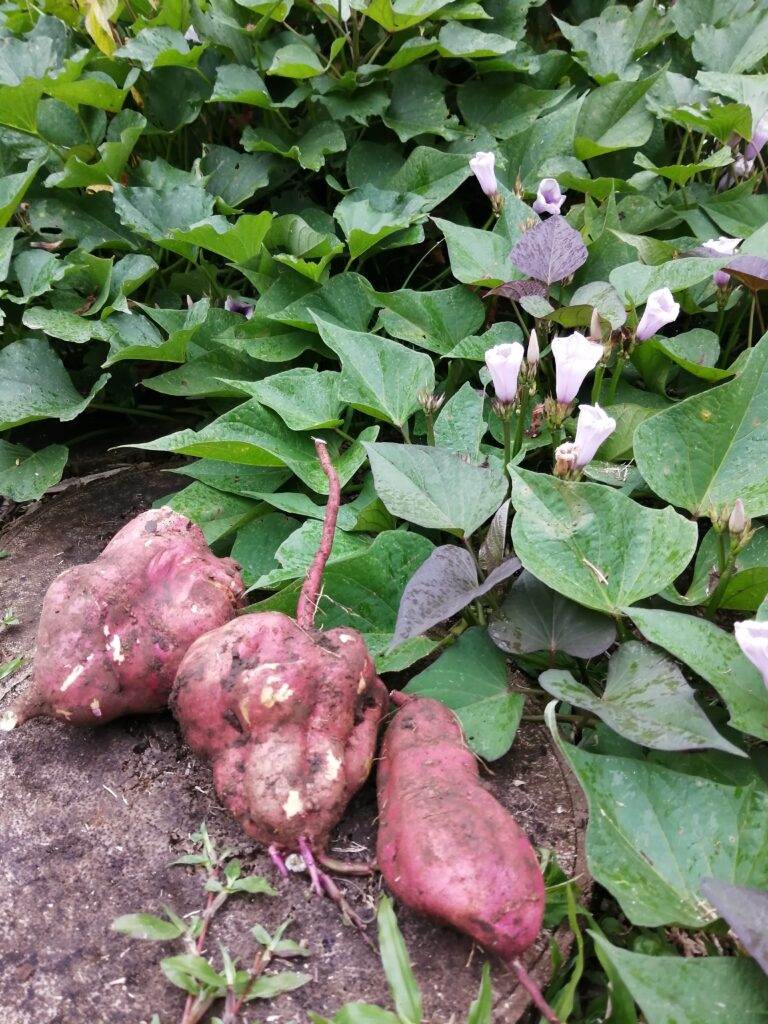
Difference Between Sweet Potatoes and Yams
Due to the nature of common names, there exists confusion regarding the difference between Sweet Potatoes and Yams. In the proper sense, Yams are not related to Sweet Potatoes at all. They have some physical similarities but actually originate from a completely different lineage in the plant kingdom. Yam refers to members of the genus Dioscorea while Sweet Potatoes are one of the many cultivars of the species Ipomea batatas.
Confusion occurs because in the United States the term Yam is often used to describe certain types of Sweet Potatoes. While this common-name holds true in these traditional contexts, to an international and botanically trained community it is improper. True Yams rarely actually make it to the grocery stores in the United States and are mostly found in tropical regions. Despite both being great root-crops, true yams are actually more related to grasses than sweet potatoes!
Description
Sweet Potato (Ipomea batatas) is an herbaceous and low-growing perennial vine native to the tropics. It is in the Convovulaceae family and related to the ornamental morning glories (Ipomoea purpurea) common in home gardens. While this may be a surprise to many, the heart-shaped foliage and flowers of Sweet Potatoes bear a striking resemblance to anyone familiar with morning glories.
While the young tips and leaves of Sweet Potato are edible and enjoyed in many parts of the world, it is most valued for its starchy and delicious root. Unlike Potatoes, which are technically modified stems known as “tubers”, Sweet Potatoes are actually enlarged storage roots of the plant.


Sweet Potato is native to the Americas, and believed to have been first domesticated somewhere between south eastern Mexico and Venezuela. From here it was quickly spread across Central America and northern South America.The oldest known record of Sweet Potatoes were discovered in southern Peru within caves and radio-carbon dated more than 10,000 years in age.

Polynesians who visited the Americas in pre-columbian times spread Sweet Potatoes across to Hawaii, New Zealand, Papua New Guinea, and various places of Polynesian influence well over 1000 years ago. Today, Sweet Potato is cultivated around the world, both in tropical and temperate climates.
Varieties of Sweet Potato
Due to its long history of domestication and spread, it is no surprise that there are countless varieties of sweet potatoes in existence. The most notable characteristics of these are the colors of the edible roots. These range from orange to red to purple or simply white. Shape, size, and density also greatly vary. Along with these differences there are unique flavors, nutritional benefits, and gastronomic qualities to each of these varieties.
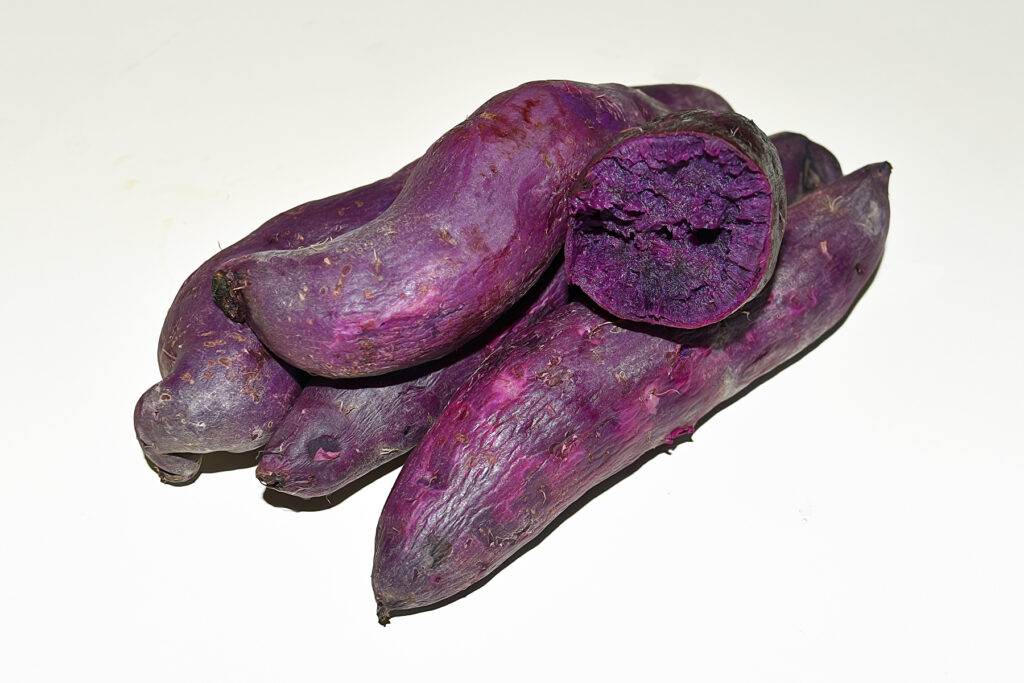

Likewise, different varieties also have unique climatic and cultivation preferences. Quick to mature varieties originating from the montane tropics are best suited for higher altitude and northern latitudes. Certain varieties are also more drought-tolerant or heat resistant. Obtaining propagation material from local sources is a great way to ensure you have a variety that is suitable for tour climate.
Cultivation
The cultivation of sweet potatoes is a straightforward and simple process. Planted in the right conditions, sweet potatoes grow with ease and have relatively low-labor costs. They love warm temperatures and can be harvested in as little as 4 months if conditions are right. For first time growers it often feels miraculous and unbalanced to harvest such a delicious crop, grown with so much ease.
Propagation
Sweet potatoes are propagated using vegetative cuttings. These are often called “slips” in the case of sweet potatoes. Unlike regular potatoes, they are not typically propagated with “seed potatoes” which are small tubers left-over from the previous harvest. This being said, it is not unheard of to use root material for direct propagation although it is not always the most effective.
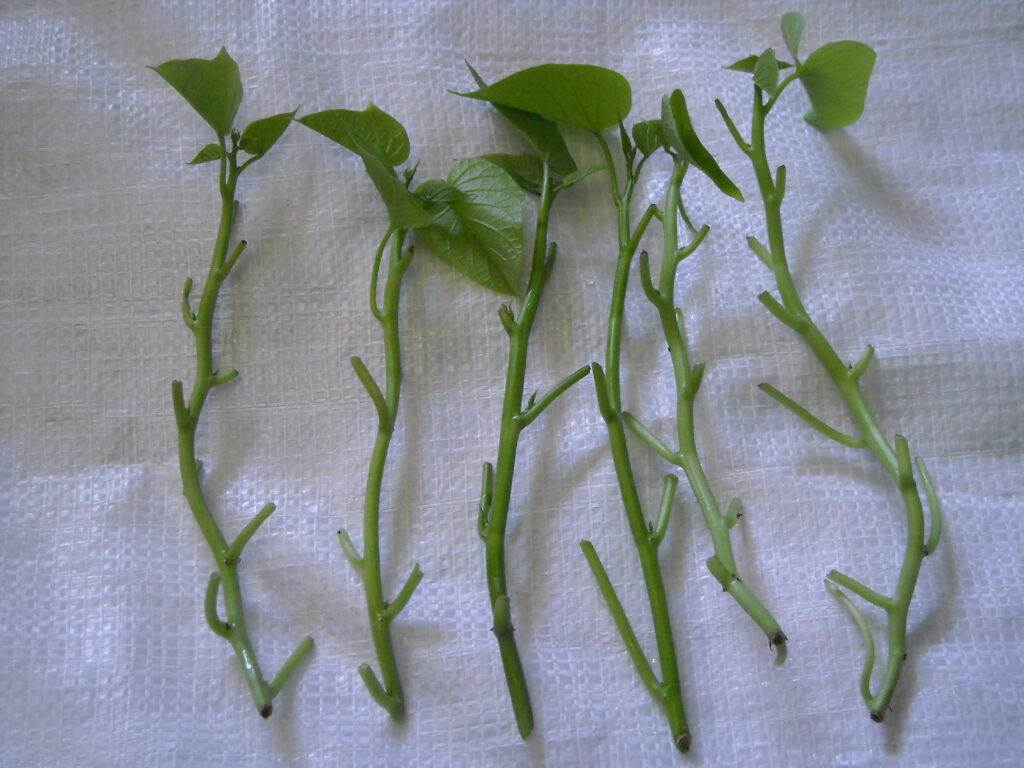
There are two main ways to get your hands on some slips.
- From An Existing Plant: If you already have a relatively mature plant, it is easy to get some slips from it. Make sure it is free of illness or disease before harvesting slips to avoid getting a bad start. Slips are also abundant directly after a harvest from any left-over above ground vegetation. Get your slips from vigorous and healthy foliage. You want them to be about 15-30 cm (6-12 in) in length.
- Root Sprouts: If you can’t get your hands on slips directly, it is possible to induce sprouting from commercially available sweet-potatoes. If you are purchasing these from a vendor, ideally get organic and locally produced sweet potatoes. The sprouts that grow directly from the Sweet Potato can then be used as slips. This process takes about 2-4 weeks in warm weather and could take up to 2 months in cooler weather. Slips can be planted directly into moist soil or further rooted in water or soil. To induce sprouting there are two main methods.
- The easiest is to simply submerge a sweet potato about half-way lengthwise in water. It is best to have the pointy end facing down and the rounder end up. This can easily be done in a cup or mason jar, some people choose to support the sweet potato with toothpicks but this isn’t absolutely necessary.
- Alternatively you can lay a sweet potato on its side and bury it half way in a moist soil. This often is faster than the water method, but requires more care to keep the soil moist. If you are having trouble with retaining moisture you can mulch around the sweet potato. Alternatively, loosely cover it with plastic wrap and punch some holes into it to allow for some air-exchange. Make sure you have drainage, because although the roots are fine submerged in clean water they may suffer in water-logged soil. Alternatively, if the climate permits you can bury a sweet-potato somewhere in the garden. Within 4-8 weeks there should be considerable growth and good slips for you to harvest.
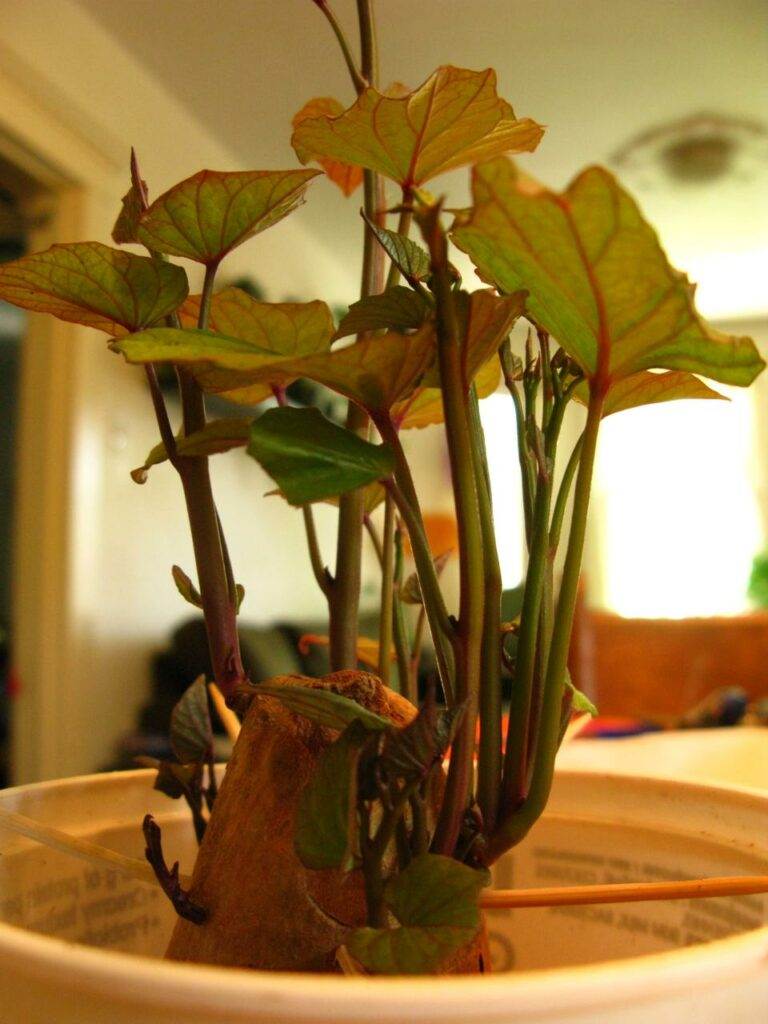
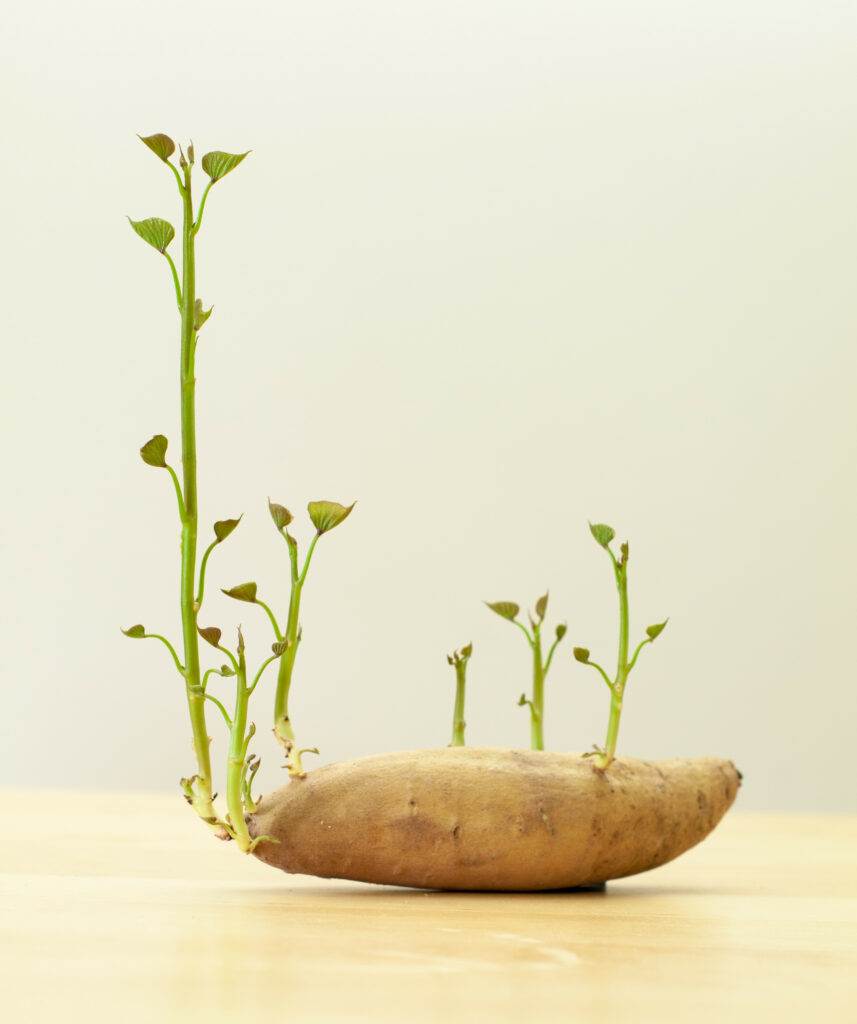

Preparing Your Slips
You want your slips to be about 15-30 cm in length (6-12 inches). Remove the lower leaves and any diseased foliage before planting. If you are planting directly to soil and are in a moisture-limited environment a longer slip may be favorable. You can also place your slip to root in clean water or a pot for a couple weeks before planting so it has an already developed root system.
Growing Sweet Potatoes
In temperate zones, planting should occur well past the threat of last frost in mid to late spring. For many people this is usually between May-June or once soil temperatures do not drop below 10C (50F). If you’re in the tropics, you may be able to plant year-round but it is best to avoid excessively dry times of the year (unless you have irrigation). If you’re in a tropical climate with a relatively cold season, it is best to plant at the end or after this time period.
Sweet Potatoes love full-sun but can also grow properly in partial shade. Their low-growing habit makes them an excellent understory and ground cover between medium to small fruit trees with open canopies. It is important to consider that sweet potatoes grow vigorously. They can easily take over gardens and outcompete other plants. Make sure to give it proper space to grow and spread.
Preparing Your Soil
Sweet Potatoes do best in loose and well draining soils. This allows them to easily expand their tuberous roots and ensure a great harvest. This being said, they can successfully grow in heavy clay-soils, be it you avoid any water-logging. Water-logging can cause illness, root-rot, and a significant decrease in yield. If you are planting in areas prone to waterlogging, it is recommended to plant in raised beds or mounds.
Before planting it is best to loosen the top 30-40 cm (12inches) of the soil and remove any nasty and unwanted weeds. Compacted soil restricts root-growth and may cause the tubers to grow above the ground. While this isn’t particularly harmful, it may attract rodents and other pests who may nibble on your crop. Surface growth can also promote cracking.
Weeding is the most laborious task when cultivating sweet-potatoes, so removing them as best as possible before planting is worthwhile. Add 1-2 gallons of well-aged compost per-plant before planting in infertile soils. Sweet Potatoes actually don’t require too much nutrients, and an excess of nitrogen may actually result in large vegetative growth with small tubers. Planting directly into beds that were previously amended for winter/spring crops (broccoli, cauliflower, sweet peas, ect.) is a great option too.
Planting Slips
For planting, simply bury your slips halfway into the soil. There only needs to be about 5-10 cm (2-4 inches) of vegetation above the soil. Space your slips around 15-20 cm apart (about 6 inches), ensuring each has enough room to grow and spread. In many cases large tuberous roots will develop exactly where you planted them, but sometimes the plants spread from there and form their tubers in other locations.
A thick layer of mulch around your slips will help reduce evaporation and risk of your soil drying out. If you are experiencing particularly dry and hot conditions, consider providing some shade to your freshly planted slips.


Maintenance
Sweet Potatoes are a relatively care-free crop. They grow vigorously and often have little issues with pests and disease. It is recommended to regularly remove unwanted weeds and vegetation that can compete with your plants. This is particularly true if you have any fast growing grasses or nasty weeds that are growing between your crops.
You will likely see that grasshoppers and many other leaf-eating insects are attracted to Sweet Potato vines. In most cases, these are not heavily detrimental and won’t drastically affect the yield of your crop. In cases where there is rampant growth and severe damage caused by these insects you may want to try applying diatomaceous earth or other repellents.
If you are experiencing heavy rains and flooding in your Sweet Potato patch it may be beneficial to create some small drainage channels to reduce water-logging. If you are experiencing dry-conditions it is best to irrigate and apply a thick-layer of mulch as needed. Excessive drying of the soil can lead to cracking and damage of the tuberous roots.
Pests and DIsease
Sweet Potatoes are a relatively resistant crop that doesn’t usually have too many issues with pests and disease. Many growers even cultivate them in the same beds for several years without encountering problems. This being said, they are not invincible. This is especially true if you have unfavorable climatic conditions where they become susceptible to disease. Water-logging and cold-weather are two common factors that lead to disease in Sweet Potatoes.
One of the most common reasons people encounter disease is because they use infected propagation materials, or they plant in a plot that was previously infected. For this reason it is incredibly important to only use healthy and robust propagation material. If you ever have infected plants or tubers, make sure to dispose of them adequately to avoid spreading them into your environment.
Sweet Potato Weevil
The Sweet Potato Weevil is a common pest that attacks Sweet Potato tubers. It is technically the larvae of the Weevil which cause the damage. These larvae may damage the tubers throughout the growing season, but often their damage occurs during storage.
If there are any signs of this weevil damage in your harvest, check your Sweet Potatoes thoroughly before storage. Toss or consume infected materials immediately. Avoid replanting Sweet Potatoes in the same plot or bed for 3-4 years. Dry soil conditions cause them to proliferate. Thick layers of mulch can be used to reduce infection during the growing season.

Harvest
Harvesting is the most exciting and fun part about Sweet Potatoes. Since you rarely see the bounties that lay below the soil, it is a lot like unwrapping a present! Harvesting usually occurs 4-5 months after planting, often after you begin seeing yellowing of the leaves. While you can leave your plants for longer (especially in tropical climates), tubers can become more fibrous if left for too long.
- It is best to start by removing all the above ground vegetation. If you want good propagation material, this is a good time to collect some slips. Be wary, that in moist climates any above ground vegetation left on the soil is prone to rooting and may start growing. While this is usually welcome by most growers, make sure it is not invading in a garden or growing in an unwanted location!
- Once you’ve removed the above-ground vegetation you will likely see a couple tuberous roots peeking their heads above the ground. This is particularly true if you were growing in compacted soils. Regardless there are many other tubers hidden below the soil so it is good to take precaution when digging them out to avoid damaging them.
- Begin by removing any tubers that are visible from the soil. Afterwards, begin lifting up the soil with a digging-fork (or shovel if that is all you have) to reveal any buried tubers. Continue doing this systematically, placing your digging fork at the edge of the place you last dug to avoid striking any tubers. Scan the soil for any more that may be buried.
Ideal tubers are dense, tough, and have no signs of damage or cracking. While extremely large tubers are exciting, they can often be tougher and more fibrous than smaller ones. Ideal size is about 15 cm (6 inches) in length although this depends on the growth conditions and the specific cultivar. Damaged or fibrous tubers can still be eaten, or they can be used for propagation.
Note: Don’t forget that young Sweet Potato shoots and leaves are also completely edible! It is best to eat only the tender ends of the vines and avoid woody or fibrous parts. These can be eaten throughout the growing season and cooked as you would other leafy-green vegetables. While this is unfamiliar to many people, Sweet Potato greens are actually delicacies in many parts of the world!
Curing and Storing Sweet Potatoes
With proper care, Sweet Potatoes can be stored for months after harvesting. It is important to remember that these tuberous roots are alive and that ensuring their longevity relies on providing adequate environmental conditions.
- Once harvested, separate any damaged or diseased tubers. These will not store well and should be consumed as soon as possible or used for propagation material. If not, they can be composted or fed to livestock.
- Remove excess dirt from Sweet Potatoes but do so gently to not damage their skin. Do not wash with water or scrub as this will actually reduce the shelf-life.
- Curing is a process that not only lengthens the storage but also makes for a more flavorful Sweet Potato. During the curing process starches are converted into simpler sugars resulting in a sweeter and more delicious flavor. To cure it is recommended to keep your Sweet Potatoes in a hot and humid environment. This means 25-35C (80-95F) and >80% humidity. Keeping them in a box near a furnace or heater is a great way to achieve this if the climate alone won’t permit. Cure them for about 10 days.
- Afterwards for storage you will want to keep them in a cool environment, but avoid temperatures below 10C (50F). Due to their tropical origin they are sensitive to cold temperatures which can promote fungal and bacterial growth.
- Consume your Sweet Potatoes as needed but check them routinely for any signs of mold, mildew, or other pests. Remove any infected materials immediately to reduce the spread of disease.
Eat and Enjoy!
Growing Sweet Potatoes is a fun and easy process, but eating them is the best part. There are countless ways to prepare them and they can be fit into almost any type of meal. In some places they are even fermented into alcoholic beverages! Whatever recipe you choose to follow, enjoy the bounty of the harvest!






































